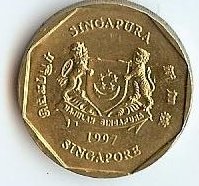|


The dollar (sign: $; code: SGD) is the currency of Singapore. It is normally abbreviated with the dollar sign $, or alternatively S$ to distinguish it from other dollar-denominated currencies. It is divided into 100 cents.
History
Between 1845 and 1939, Singapore used the Straits dollar.This was replaced by the Malayan dollar, and, from 1953, the Malaya and British Borneo dollar, which were issued by the Board of Commissioners of Currency, Malaya and British Borneo.
Singapore continued to use the common currency upon joining Malaysia in 1963 but, two years after Singapore's expulsion and independence from Malaysia in 1965, the monetary union between Malaysia, Singapore and Brunei broke down.Singapore established the Board of Commissioners of Currency, Singapore, on April 7, 1967 and issued its first coins and notes.Nevertheless, the Singapore dollar was exchangeable at par with the Malaysian ringgit until 1973,and interchangeability with the Brunei dollar is still maintained.
Initially, the Singapore dollar was pegged to the British pound sterling at a rate of S$60 = £7. This peg lasted until the demise of the Sterling Area in the early 1970s, after which the Singapore dollar was linked to the US dollar for a short period of time. As Singapore's economy grew and its trade links diversified to many other countries and regions, Singapore moved towards pegging its currency against a fixed and undisclosed trade-weighted basket of currencies from 1973 to 1985. From 1985 onwards, Singapore adopted a more market-oriented exchange regime -classified as a Monitoring Band -in which the Singapore dollar is allowed to float (within an undisclosed bandwidth of a central parity) but closely monitored by the Monetary Authority of Singapore (MAS) against a concealed basket of currencies of Singapore's major trading partners and competitors. This in theory allows the Singaporean government to have more control over imported inflation and to ensure that Singapore's exports remain competitive. All issued Singapore dollar currency in circulation is fully backed by international assets to maintain public confidence.
The Board of Commissioners of Currency, Singapore, was dissolved on October 1, 2002 and its functions, property and liabilities have been transferred to the MAS.
Coins
In 1967 the first series of coins was introduced in denominations of 1, 5, 10, 20 and 50 cents and 1 dollar. Except for the bronze 1 cent, these coins were struck in cupro-nickel. In 1985, a second series of coins was introduced in the same denominations. The sizes of the coins were reduced (most substantially for the larger denominations) and the 5 cents was struck in aluminium-bronze. In 1987, the 1 dollar coin was further reduced in size and switched to being struck in aluminium-bronze.
Note:
- 6.81 million 1 cent coins are in circulation as at 1 December 2006, but are no longer issued since 2003.
- 5.86 million 5 cent coins are still in circulation as at 1 December 2006, but are no longer issued.
`
Banknotes
On June 12, 1967, the first series of notes, known as the Orchid series, was introduced in denominations of $1, $5, $10, $50, $100 & $1000. $25 & $500 notes were introduced in 1972, followed by $10,000 in 1973. Between 1976 & 1980, the Bird series was introduced, including a $20 note introduced in 1979. This series did not include a $25 note. The Ship series was introduced between 1985 & 1989 in the same denominations except for the absence of a $20 note. $2 notes were introduced in 1990.
The current Portrait series was introduced in 1999, with the 1 and 500 dollar denominations omitted. These notes feature the face of Yusof bin Ishak, the first president of the Republic of Singapore, on the obverse, and the reverse depicts a feature of civic virtue. There are both paper and polymer notes in circulation. The designs of the polymer notes are very similar to the corresponding paper note except for the slightly slippery feel and a small transparent window design in the corner of the banknote. Polymer notes are progressively replacing the paper banknotes in circulation. The notes also has Braille pattern at the top right-hand corner of the front design.
Commemorative Banknotes
Commemorative banknotes are also released, usually in limited quantities. The first commemorative banknote was released in 24 July 1990, to celebrate the 25th anniversary of Singapore's independence. On 8 December 1999, to celebrate the coming millennium, 3 million $2 millennium notes were circulated. The note is similar to the $2 portrait series, except that the prefix of the serial number is replaced with a Millennium 2000 logo. On 27 June 2007, to commemorate 40 years of currency agreement with Brunei, the $20 note was launched; the back is identical to the Bruneian $20 note launched concurrently. A circulation version of the $20 note can be exchanged at banks in Singapore beginning July 16, 2007, limited to two pieces per transaction.
The text on this page has been made available under the Creative Commons Attribution-ShareAlike License and Creative Commons Licenses
|
